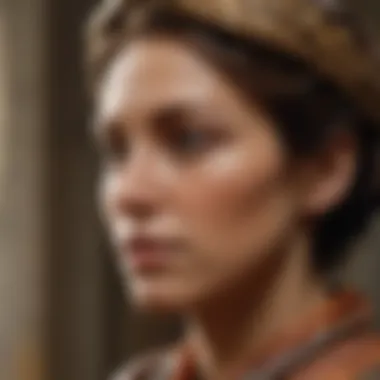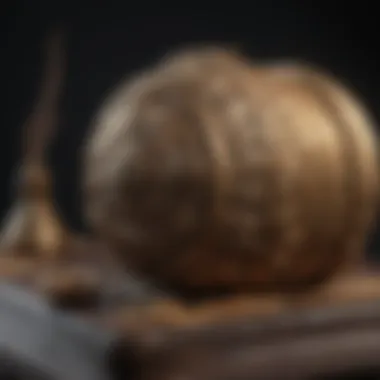Mastering the Craft: A Comprehensive Guide to Cast Making Materials and Techniques


Rock and Fossil Identification
Rock and fossil identification is a fundamental aspect of the art of cast making. Understanding the types of rocks and fossils is crucial for creating accurate and detailed casts. Different rocks and fossils possess unique characteristics that provide valuable insights into their composition and origin. Enthusiasts and professionals alike can benefit from knowing the specific features to look for when identifying rocks and fossils. Utilizing specialized tools for identification, such as magnifying glasses and UV light sources, can enhance the precision of the identification process.
Collecting Tips and Techniques
Effective collecting tips and techniques play a pivotal role in acquiring high-quality specimens for cast making. Professionals emphasize the importance of following best practices when collecting rocks and fossils to ensure the integrity of the specimens. Locating prime collecting sites, whether they are geological formations or specific territories, requires meticulous research and exploration. It is essential to exercise caution and adopt proper techniques when extracting specimens to prevent damage to both the specimens and the environment.
Preservation and Display
Preservation and display techniques significantly impact the longevity and aesthetic appeal of casted rocks and fossils. Various preservation methods, such as using consolidants and protective coatings, help maintain the structural integrity of the casts over time. Proper storage methods, including humidity control and protection from sunlight, are essential to prevent deterioration. Creative display ideas, such as incorporating lighting effects and thematic arrangements, enhance the visual impact of casted rocks and fossils, making them engaging and educational for viewers.
Geological Insights
Geological insights provide valuable context to the world of cast making, offering a deeper understanding of the rocks and fossils being replicated. Exploring geological formations and processes sheds light on the natural occurrences that shape our planet's landscape. Additionally, delving into the historical significance of rocks and fossils uncovers their contributions to scientific research and human knowledge. Notable discoveries in the field of geology further emphasize the importance of continuous exploration and study in expanding our understanding of the Earth's history and evolution.
Introduction
In the realm of artistic expression and intricate craftsmanship, the art of cast making stands as a venerable practice that intertwines history, innovation, and meticulous skill. This introductory section serves as the gateway to a comprehensive exploration of the materials and techniques that underpin this art form, catering to both aficionados and seasoned professionals immersed in the world of cast creation.
As we embark on this journey into the realm of cast making, it is essential to grasp the significance of mastering this craft. Whether one delves into this art for recreational purposes or pursues it as a career, understanding the nuances of cast making opens a portal to unleash unparalleled creativity and precision. The ability to transform a mundane object into a detailed replica requires a blend of technical proficiency and artistic vision, making this an endeavor that demands attention to detail and a keen eye for aesthetics.
Throughout this article, we will delve into the essence of cast making, shedding light on the historical roots that have shaped this practice over centuries. From ancient civilizations employing casting techniques to modern-day innovations fueling artistic revolutions, the evolution of cast making is a tapestry of human ingenuity and creative exploration.
Moreover, this section will outline the different types of casts, ranging from simple molds for basic shapes to intricate casts that capture the essence of complex forms with finesse. By dissecting the diverse array of cast types, readers will gain a comprehensive understanding of the versatility and applicability of casting in various fields, from art to industrial design.
Prepare to immerse yourself in the world of cast making, where every mold, every pour, and every release embodies a meticulous dance between tradition and innovation, heritage, and contemporary vision.
Understanding Cast Making


Understanding cast making is a fundamental aspect of the art, serving as the backbone for creating intricate and precise replicas. In this article, we delve deep into the world of cast making, shedding light on its significance in both traditional and modern contexts. A thorough understanding of cast making allows enthusiasts and professionals to explore a myriad of techniques and materials, enabling them to push the boundaries of creativity and craftsmanship.
Defining Cast Making
Defining cast making involves the process of creating detailed replicas or reproductions of objects using various materials such as plaster, silicone rubber, and resin. It is a meticulous craft that requires precision and attention to detail to capture the essence of the original object effectively. Cast making bridges the gap between art and science, allowing for the preservation and replication of objects for various purposes.
Historical Significance
The historical significance of cast making traces back centuries, playing a vital role in preserving cultural heritage and scientific advancements. Ancient civilizations utilized casting techniques to immortalize artifacts and monumental structures, providing valuable insights into past societies. Throughout history, cast making has evolved from traditional methods to modern innovations, showcasing its enduring relevance in art, archaeology, and research.
Types of Casts
There are various types of casts used in different applications, including waste molds, gelatin molds, and segmented molds, each offering unique advantages depending on the desired outcome. Waste molds are commonly used for one-time casts, while gelatin molds allow for intricate details and flexibility. Segmented molds are ideal for complex shapes and arrangements, making them versatile for a range of casting projects. Understanding the different types of casts is essential for achieving the desired results in cast making.
Essential Materials for Cast Making
In the realm of cast making, the choice of materials plays a pivotal role in the outcome of the final product. The section on Essential Materials for Cast Making in this in-depth guide serves as a cornerstone for enthusiasts and professionals alike. Understanding the nuances and attributes of different materials is key to achieving precision and creativity in cast making.
Plaster of Paris
Plaster of Paris is a fundamental material in cast making due to its versatility and ease of use. Its ability to capture intricate details makes it a popular choice among artists and craftsmen. When mixed with water, Plaster of Paris forms a workable paste that sets hard relatively quickly, allowing for efficient mold creation. Its affordability and availability further contribute to its widespread use in the field of cast making.
Silicone Rubber
Silicone rubber is renowned for its flexibility and durability, making it a preferred material for creating molds that require frequent use or demolding. Its resistance to heat and chemicals adds to its appeal, ensuring longevity and stability in various casting applications. Silicone rubber can capture fine details with high precision, making it an ideal choice for intricate reproduction work.
Alginate
Alginate, derived from seaweed, offers a unique advantage in creating extremely detailed and accurate molds. Its fast-setting properties make it ideal for capturing impressions of body parts or delicate objects. Alginate is often used in medical and dental fields due to its non-toxic nature and ability to produce high-resolution molds.


Latex
Latex is valued for its elasticity and resilience when creating flexible molds. Its tear resistance and durability make it suitable for casting materials that need to be bent or twisted without losing shape. Latex molds are favored in prosthetics and special effects industries for their ability to withstand repeated use.
Resin
Resin is a versatile material that can be tinted, filled, or manipulated to achieve specific characteristics in casts. Its quick curing time and durability make it a popular choice for creating robust and detailed objects. Resin casts can range from transparent and glossy to opaque and textured, offering a wide range of artistic possibilities for cast makers.
Traditional vs Modern Technique
When delving into the realm of cast making, understanding the dynamics between traditional and modern techniques is paramount to mastering this art form. The juxtaposition of traditional methods against modern innovations provides a fascinating insight into the evolution of cast making. Traditional techniques carry a rich historical legacy, rooted in age-old practices that have stood the test of time. These methods, honed over generations, offer a sense of authenticity and time-honored craftsmanship. On the other hand, modern innovations bring forth a wave of technological advancements and efficiency that streamline the casting process. Embracing modern techniques can enhance precision, speed, and overall quality of the final cast. The crux lies in striking a balance between tradition and innovation, leveraging the best of both worlds to create casts that exemplify artisanal expertise combined with contemporary finesse.
Traditional Method
In the realm of cast making, traditional methods hold a revered position, embodying heritage and legacy. Traditional techniques often involve using materials like plaster of Paris and silicone rubber in meticulous processes that emphasize craftsmanship and attention to detail. One of the key advantages of traditional methods is the hands-on approach they necessitate, fostering a profound connection between the artist and the art piece being cast. Craftsmanship reigns supreme in traditional cast making, with artisans employing time-tested techniques to create intricate and high-quality casts. While traditional methods may require more time and effort compared to modern approaches, the end result often exudes a sense of authenticity and craftsmanship that is unparalleled.
Modern Innovation
On the flip side, modern innovations in cast making introduce a wave of technological advancements that revolutionize the casting process. Materials like resin and advanced silicones have opened up new possibilities for artists and professionals, allowing for greater flexibility, durability, and detail in casts. Precision is a hallmark of modern techniques, with cutting-edge tools and materials enabling artists to achieve intricate designs with ease. Moreover, modern innovations emphasize efficiency and repeatability, making mass production of casts a viable option for various industries. Embracing modern innovations in cast making can significantly streamline the production process while maintaining high standards of quality and detail.
Advanced Applications
In the realm of cast making, advanced applications play a crucial role in pushing the boundaries of creativity and functionality. This section delves into the sophisticated uses of casting techniques, aiming to provide a comprehensive understanding for both enthusiasts and professionals. By exploring advanced applications, individuals can unlock innovative possibilities that elevate their craft to new heights.
Industrial Uses
Industrial applications of casting techniques are vast and diverse, serving various sectors such as manufacturing, automotive, aerospace, and more. The precise replication of intricate parts and components through casting allows industries to streamline production processes, reduce costs, and enhance product quality. By adopting advanced casting methods, companies can achieve greater efficiency and consistency in manufacturing, leading to improved overall outcomes.
Artistic Expressions


Artists harness the power of casting to express their creativity in unique ways, shaping materials into stunning forms that captivate audiences. From sculptors creating intricate sculptures to designers crafting decorative elements, casting offers a versatile medium for artistic expression. The intersection of art and casting opens up a world of possibilities, enabling creators to transform their visions into tangible works of art that inspire and enchant.
Medical Innovations
The field of medicine benefits significantly from casting innovations, with applications ranging from prosthetics to dental restoration. Casting techniques aid in producing custom-fit medical devices that enhance patient care and outcomes. By leveraging advanced casting materials and methods, medical professionals can create precise and tailor-made solutions that improve quality of life for individuals in need. The integration of casting in medical innovation showcases the interdisciplinary nature of this art form, contributing to advancements in healthcare and well-being.
Best Practices and Tips
In the intricate world of cast making, adherence to best practices and tips plays a pivotal role in ensuring a successful and high-quality outcome. Emphasizing this aspect in the comprehensive guide enhances the reader's understanding of the significance of precision and care in every step of the casting process. By delving into the specifics of best practices and tips, this section aims to provide rock and fossil collectors with a detailed roadmap towards achieving optimal results.
Safety Precautions
When engaging in cast making, prioritizing safety precautions is non-negotiable. This section delves into the critical measures that need to be adhered to, such as the utilization of personal protective equipment, ensuring proper ventilation in work areas, and understanding the potential hazards of certain casting materials. By highlighting the importance of safety, rock and fossil collectors can carry out their casting activities with confidence and peace of mind.
Precision Techniques
The precision required in cast making is akin to artwork - every detail counts. This section explores the techniques essential for impeccable casting results, including accurate measurement mixing ratios, meticulous application processes, and the use of advanced tools for intricate designs. Understanding and implementing precision techniques are fundamental to creating flawless casts that mirror the finest details of the original objects.
Cleaning and Maintenance
Maintaining the longevity and quality of casts extends beyond the casting process itself. This section illuminates the significance of post-casting care, encompassing thorough cleaning methods to remove residue and ensuring proper storage conditions to prevent degradation. By delving into cleaning and maintenance practices, rock and fossil collectors can preserve their casts for years to come, retaining their aesthetic appeal and structural integrity.
Conclusion
Importance of Conclusion in this Article
The conclusive segment functions as a synthesis of the vast array of information covered throughout the guide. It provides a crucial space for reflection, offering readers a moment to assimilate the discussed materials and techniques. Comprehensively, the conclusion encapsulates the essence of why mastering cast making is a valuable skill set for both amateurs and professionals.
Specific Elements and Benefits
One of the primary aspects highlighted in this conclusion is the wide-ranging applications of cast making in different spheres such as art, industry, and medical fields. By grasping the materials and techniques discussed in this guide, individuals can unlock creativity and precision in their crafting endeavors. Moreover, the conclusion emphasizes the importance of attention to detail and safety measures in cast making, underlining the professional standards that practitioners should adhere to.
Considerations about Conclusion
It is imperative to recognize that the conclusion not only serves to wrap up the discourse but also hints at the endless possibilities that mastering the art of cast making can offer. As readers internalize the content presented in the guide, the conclusion acts as a springboard for further exploration and experimentation in this intricate craft.







